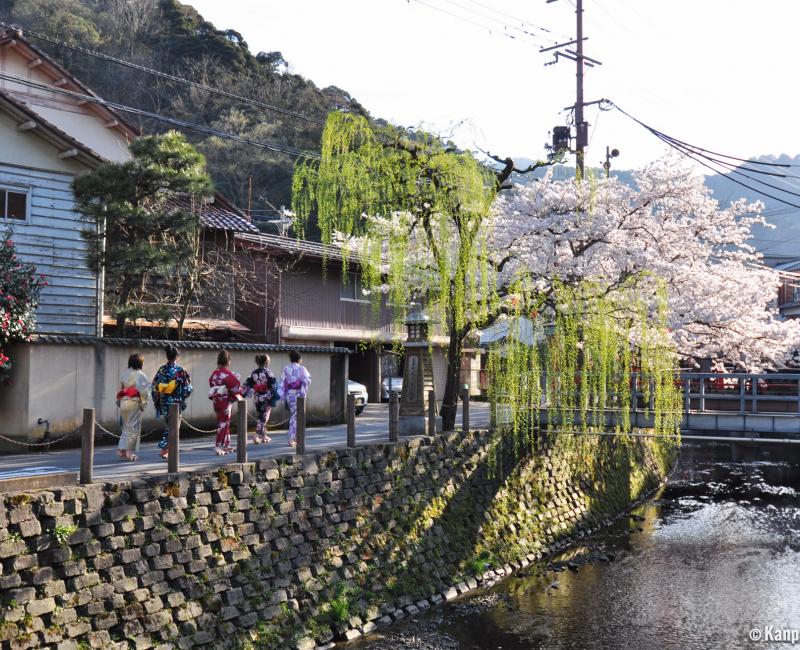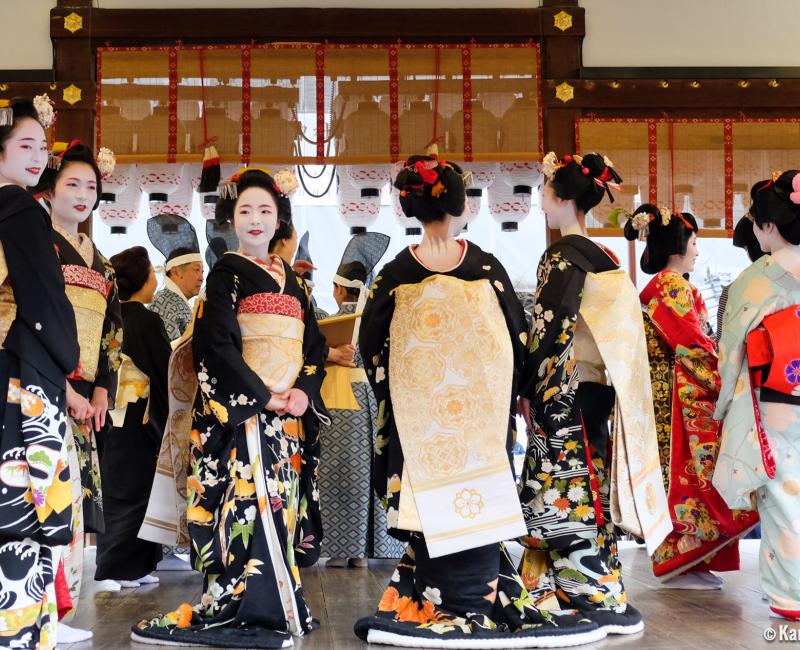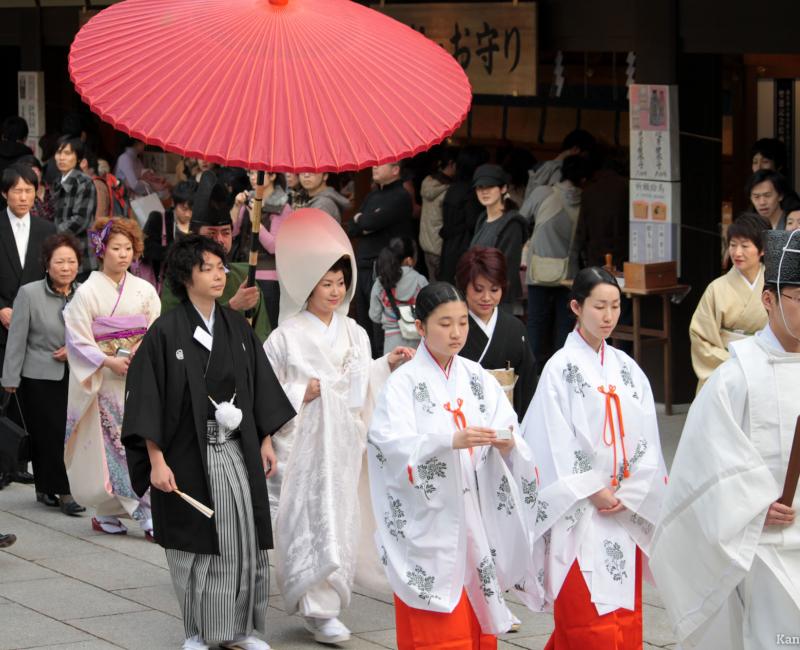Kimono and Yukata
👘 The Traditional Japanese Clothing
Every Japanese, regardless of gender or age, and even children as soon as they can walk, will wear a kimono 👘 or a yukata at least once during their life. Traditional clothing is not worn on a daily basis anymore, but many Japanese do enjoy donning them for special or formal occasions or for the fun of it, especially in summer.
In the western collective unconscious, a kimono is either a cloth to practice martial arts, or a luxurious and colorful dressing gown, or sometimes geisha’s regalia. The yukata is usually unknown or mistaken with the kimono. They are in fact two types of clothes from the wafuku (和服) wardrobe, the Japanese-style clothing, defined in opposition to the Western-style clothing (yofuku 洋服).
How to differentiate a kimono from a yukata?
Kimono and yukata are both long traditional Japanese robes, closing on the front and secured by a belt named obi (帯). They are designed following the same T-shaped sewing pattern that can easily be put together thanks to fabric strips of standardized dimensions. They can be mainly differentiated by their use.
Kimono
Kimono (着物) literally means "thing to wear." Its usage is favored for peculiar occasions such as:
- Coming-of-Age ceremony (seijin no hi),
- Involvement in traditional activities (tea ceremony, attending to Noh or Kabuki plays),
- Wedding ceremony or a funeral,
- And even just for the fun of it.
The patterns’ style, the colors, etc. naturally vary according to the circumstances for which the kimono will be worn.
A kimono is most of the time made of expensive or precious fabric (such as silk), and woven with refined techniques (brocade for example), ornamented with sophisticated patterns with a strong symbolic meaning.
As for the sport outfit keikogi (稽古着), it is often incorrectly called kimono in Western countries, but it only belongs to martial arts dojos.
Yukata
Yukata (浴衣) means "bathing cloth" and is part of the summer wardrobe. It is one of the Japanese’s favorite apparel to go to the traditional festivals. Unlike the kimono, the yukata can be worn directly on bare skin. It is lighter, and more suitable for summer’s temperatures, and also more relaxed. It is often made of cotton, sometimes of polyester and provides a large variety of patterns to choose from.

A bit of history
The kimono
The kimono’s present-day shape, named kosode (小袖 "short sleeves"), in opposition to the traditional shape named furisode (振袖, "long sleeves"), spread in the 16th and 17th centuries, after a gradual simplification of typically Japanese clothing styles developed since Heian period (794 - 1185). The kimono became a universal dress, for men as well as for women, and worn daily by all classes in the society, with the exception of warriors.
During Edo period (1603-1868), the shogunal government passed strict "sumptuary laws" that precisely defined how to wear the kosode, the type of patterns, materials, weaving techniques or colors that were authorized depending on the social class, occupation, gender, marital status, etc. Clothing was thus comparable to a social identity card. In late Edo period, the general codification to wear kimono was so complex that merchants had to use thick catalogs to help their customers chose the appropriate robe.
Meiji Era (1868-1912) saw the introduction of the Western-style clothing in the Japanese wardrobe. It was first worn as such, as an outward sign of modernity, and later mixed with Japanese-style clothes. In the same period began the distinction between wafuku and yofuku, and the term "kimono" was created to replace kosode.
The encounter with other civilizations has nourished and still helps the traditional cloth to evolve. As many of its counterparts in the world, whether men or women clothes, the kimono conveys a message. The importance of symbolism is strong and is displayed in many ways that can overlap:
- The length of the sleeves tells of a woman’s marital status,
- Patterns show the kimono wearer’s cultivation or have propitiatory properties,
- Types of fabrics and weaving techniques show its owner’s wealth,
- Etc.
And it is still true nowadays.

The yukata
The history of yukata seems less intricate than the kimono’s. Its use was reported during the Heian period (794 - 1185), among the nobility. As it was frequent that several persons perform ritual ablutions at the same time, the use of the yukata developed with the primary will to hide the bare body. It was initially made of hemp fibers, a fabric that quickly dries. Its use spread to the rest of the society during Azuchi-Momoyama period (1573-1603): it was then worn when going out the bath, as a drying cloth. In the beginning of Edo period, it entered in the commoners’ daily wardrobe.
Starting from a cloth for bathing and after bath time, then a night gown, the yukata was initially a cloth people wear at home. However, from Edo period, the habits became more flexible, and people started wearing the yukata in the evening for matsuri or fireworks 🎆, in places where no formal attire was necessary.
The yukata gradually became a fashion accessory to go out, to the point that the current yukata etiquette includes wearing underwear. The under clothing can be of Western style, but the Japanese-style underwear, such as hada juban (肌襦袢 "skin cloth") is recommended.
First a simple cloth in hemp fibers, or white cotton dyed or ornamented with traditional dyeing indigo (deep blue) patterns, the yukata has integrated a large array of patterns and colors along its evolutions and thanks to the influence of the western apparel. Nowadays, most of them are industrially produced, in cotton or with fabrics mixing hemp and polyester.
Note that the yukata provided by ryokan and luxurious hotels 🏨 are to be used in their precincts or immediate surroundings. Like their predecessors, they are meant to hide the bare body when going out the bath, between the baths or as sleeping gowns. Beside onsen ♨️ towns, avoid wandering only dressed in a ryokan yukata!
Extraordinary kimonos and yukatas
Wearing kimono or yukata is customary throughout Japanese society, but some traditional clothing, despite sharing the same origins, are reserved for specific persons, who are distinguished by their occupation or their role. We selected a few examples that often appear when imagining the traditional Japanese robe.

Geisha
When talking about kimono, the first example to usually pop to mind is probably the geisha, or the courtesans pictured in etchings. Geisha and their apprentices the maiko, don the kimono on a daily basis, but they have introduced wearing codes and usages, different from the general population’s, and adapted to their artistic occupation.
Their robe is usually longer than a normal kimono, and forms a train 🚅, the lower part of the cloth must be held to walk. A geisha’s kimono is an artwork, made with extremely costly fabrics. Each detail of her vesture, from the color of a shoe strap to the ornamental comb, or the color of the collar and the type of make-up, is imbued with a symbolic meaning that can be interesting to decipher. Some items are worn according to the seasons, such a hair decoration of rice ear in the beginning of the year, others according to the progression of the maiko in her apprenticeship, such as make-up, some obi-knotting type, hairdressing, etc.
As a general rule, like in the rest of the society, as geisha age and gain experience, their attire and hairdressing style become sober. To distinguish a geisha from a "normal kimono wearer," check for the train, the uncovered back of the neck and the make-up, that are the easiest distinctive signs.
Sumo wrestlers
Sumo wrestlers also are iconic representatives of Japanese traditions, but they first remind of hand-to-hand wrestling matches with minimal clothing. However, they are notorious for wearing the yukata at any time of the year, as it is their official clothing outside the ring. The highest ranking get to complement their attire with a scarf or a coat in winter. In the same way, the type of sandal shows a wrestler’s seniority or rank, as well as the use of tabi (足袋), a kind of socks with a divided toe, authorized from a specific ranking.
Sumo wrestlers’ yukata are taylor-made for each wrestler. The highest ranking can have their named imprinted on the fabric and they frequently offer some to their colleagues, who will proudly don a cloth sporting the name of their benefactor. They can also sport their sponsors’ colors, or of their region of origin, or just a pattern that inspires them.
When walking in the sumo districts, near Arakawa or Ryogoku you may encounter the wrestlers donning yukata with a laid-back elegance, and sometimes with quirky designs.

The bride
The white cladded silhouette of the young traditional bride is characterized by the shiromuku (白無垢), shiro (白) meaning "white" and muku (無垢) "purity." The white gown came into fashion during Meiji Era, when many Japanese customs 🛂 were mixed with Western-style practices, and especially the wedding in white. As in many Asian countries, white color was, and is still nowadays, the color of grieving, or of restraint to the least.
The shiromuku is an garment worn by the bride during a Shinto wedding ceremony. It includes a kimono with a short train, a long and heavy coat uchikake (打ち掛け) that goes down to mid-calf and a rigid headpiece covering the head. All the items are white, but they also display embroideries, with good omen motifs such as cranes or flowers.
Its sophistication, and the fact that it is difficult to dress alone, make the shiromuku an extremely expensive gown that is preferably rented for the ceremony. Rental professionals usually include the clothes, the dressing and hairdressing, as well as the traditional photo shootings in their service.
As for the groom, the vesture is sober and includes a dark color kimono (usually black) on which a clear and / or vertical stripes hakama (袴, a pleated wide-legs pants) is pulled. The finishing touch is a haori (羽織) jacket, black or the same color as the kimono, marked with the family crest mon (紋) and fastened on the chest by a thin cord ending with white tassels.
The Imperial Couple
For the enthronement ceremony in 2019, Emperor Naruhito and his wife Masako wore the Imperial Court’s traditional clothing. They were regalia directly inspired from Heian period’s formal attires that the most careful observers have already seen on the imperial couple dolls displayed during Hina Matsuri 🎎, the dolls’ festival.
The appearance of Empress Masako was certainly the most impressive: she wore the junihitoe (十二単, "12 layers cloth") which is the superposition of several kimonos of different colors, opening at the bottom to create a short round train. The layers are visible at the collar, on the sleeves and at the bottom of the robe. This robe is reserved to nobility women at the Imperial Court, and it is quite difficult to wear as it can weight up to 20 kg! Empress Masako wore at least five layers of kimonos, and her hair was arranged in a rigid wave with the volume on the back of the head, topped with a gilded comb above the forehead, as well as a makeup enhancing the whiteness of the skin.
Emperor Naruhito wore the sokutai (束帯), a formal attire dating back to the Heian period, since when it was solely worn by the emperor and the aristocrats’ sons in his family. It looks like a long and wide sleeves chasuble with a train, worn on several layers of clothes and a wide-leg pants (ueno hakama 表袴) and closed shoes with thick soles. The golden brown color of this cloth is only to use by the emperor. He was holding the shaku (笏), a scepter sign of his authority, and a short sword at his belt. On the head, he had a black lacquer hat (kanmuri 冠) topped with a 60 cm high aigrette.

Traditional clothing still at fashion’s vanguard
Kimono and yukata are clothes that offer an infinite array of styles and variety. It is probably one of the reasons of their never-ending popularity today, despite their complexity. They succeeded in modernization, first through the design of accessories to help dress alone, such as tsukuri obi (作り帯), a belt whose knot is already tied, in the same fashion as a bowtie that you just need to put on and fasten with a clip. Other adaptations concerned the types of fabrics, with the introduction of denim, motifs and accessories that never cease to get influence from other cultures, especially through collaborations with great fashion designers.
The diversity and complexity of the wafuku, the Japanese clothing, are hard to comprehend. And we did not even start to talk about items such as hakama or jimbei, which also belong to the traditional wardrobe.

